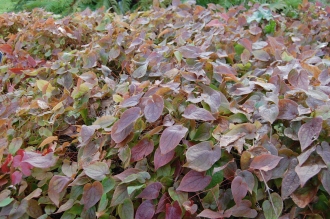Position: Dappled shade to shade
Flowering period: Spring
Soil: Moist, well drained
Eventual Height: 30cm
Eventual Spread: 45cm
Hardiness: 5a, 5b, 6a, 6b, 7a, 7b, 8a, 8b, 9a
Family: Berberidaceae
Epimedium x rubrum an evergreen herbaceous perennial with a low growing, ground covering habit. Its shiny mid green leathery leaves are divided into three heart shaped leaflets with spiny margins, each up to 6cm long and 3cm broad. Its leaves emerge pale red in spring and turn red in autumn and persist on the plant during the winter months. Its dark red and pale yellow flowers are composed of four petals, up to 2cm across, appear on stems above the foliage as a panicle of up to 30 flowers. Its roots are long rhizomes which aids its spread.
Epimedium x rubrum, commonly known as Barrenwort, Bishop’s Hat or Bishop’s Mitre, is a cross between Epimedium alpinum and Epimedium grandiflorum.
The etymological root of the binomial name Epimedium is derived from the Greek name for this plant, used by Dioscorides and Pliny. Rubrum is derived from the Latin rubra meaning ‘red’.
The landscape architect may find Epimedium x rubrum useful as an evergreen, low growing, ground cover in shady locations. This plant is not attractive to deer and rabbits. One established this perennial is drought tolerant.
Ecologically, Epimedium x rubrum is attractive to pollinating insects.
Epimedium x rubrum prefers moist, humus rich, well-drained soils. It prefers an acid to neutral pH of soil, although it will tolerate most soils.
Epimedium x rubrum requires little maintenance. Large clumps may be divided in autumn. To keep a tidy appearance old foliage may be removed in early spring.







Leave a comment